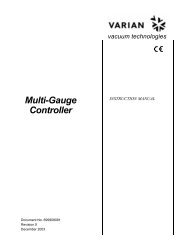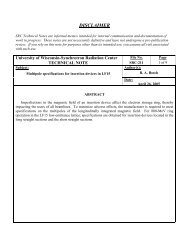Instrumentation for Synchrotron Based Micro Machining at CAMD
Instrumentation for Synchrotron Based Micro Machining at CAMD
Instrumentation for Synchrotron Based Micro Machining at CAMD
Create successful ePaper yourself
Turn your PDF publications into a flip-book with our unique Google optimized e-Paper software.
<strong>Instrument<strong>at</strong>ion</strong> <strong>for</strong> <strong>Synchrotron</strong> <strong>Based</strong> <strong>Micro</strong> <strong>Machining</strong> <strong>at</strong> <strong>CAMD</strong><br />
J. Goettert, G. Aigeldinger, Y. Desta, Z. L. Ling, and L. Rupp<br />
<strong>CAMD</strong>, Louisiana St<strong>at</strong>e Univ., 6980 Jefferson Hwy., B<strong>at</strong>on Rouge, LA 70806, USA<br />
The J. Bennett Johnston Sr., Center <strong>for</strong> Advanced <strong>Micro</strong>structures and Devices (<strong>CAMD</strong>) [1] is a<br />
synchrotron radi<strong>at</strong>ion facility owned by Louisiana St<strong>at</strong>e University and oper<strong>at</strong>ed with financial<br />
support from the St<strong>at</strong>e of Louisiana. The centerpiece of <strong>CAMD</strong> is a 1.3-1.5 GeV electron storage<br />
ring.<br />
<strong>CAMD</strong> supports a strong program in X-ray Lithography Mircomachining (XRLM) or LIGA. A<br />
total of 4 beamlines equipped with different scanners is available <strong>for</strong> exposures. A 2.500 sq.ft<br />
class 100 clean room provides basic processing capability <strong>for</strong> MEMS including optical<br />
lithography, thin film deposition, electropl<strong>at</strong>ing and metrology. Three micromachining beamlines<br />
are connected to bending magnets. All beamlines are ‘white light’ beamlines, termin<strong>at</strong>ed with a<br />
Beryllium window. The typical source point to scanner distance is 10 m and the horizontal<br />
acceptance ranges from 6.5 – 10 mrad. A number of low Z filters can be inserted into the beam<br />
adapting the exposure spectrum to the resist thickness. Two beamlines are equipped with<br />
commercial scanners from Jenoptik GmbH [2] and one beamline with a ‘vacuum’ scanner<br />
designed in house. The l<strong>at</strong>est model of Jenoptik’s DEX02 scanner has been installed <strong>at</strong> <strong>CAMD</strong>’s<br />
XRLM1 beamline in December 2000 and allows advanced exposures using overlay as well as tilt<br />
and rot<strong>at</strong>e functions (see Fig. 1). In addition to these beamlines <strong>CAMD</strong> has installed a ‘white<br />
light’ beamline <strong>at</strong> its 7T wiggler source. Preliminary exposure tests in ultra-thick samples (1mm<br />
and thicker) have been conducted using an ‘air scanner’ (see Fig. 2). Currently this beamline is<br />
dismantled and will be reinstalled together with a PX beamline.<br />
In the paper further details of the beamlines and scanners as well as some examples of<br />
applic<strong>at</strong>ions of LIGA microstructures fabric<strong>at</strong>ed <strong>at</strong> <strong>CAMD</strong> will be discussed.<br />
Fig. 1: First exposures using tilt and rot<strong>at</strong>e functions<br />
of the DEX02 scanner into SU-8 neg<strong>at</strong>ive resist.<br />
References<br />
Fig. 2: 1.78 mm tall PMMA gear fabric<strong>at</strong>ed <strong>at</strong> the wiggler<br />
beamline. The close-up views illustr<strong>at</strong>e the accur<strong>at</strong>e<br />
p<strong>at</strong>terning <strong>at</strong> the bottom and top of the gear.<br />
[1] For in<strong>for</strong>m<strong>at</strong>ion how to submit a project proposal go to: http://www.camd.lsu.edu<br />
[2] For details see Jenoptik’s webpage <strong>at</strong> www.jo-mikrotechnik.com/<br />
Submitting author: J. Goettert, e-mail: jost@lsu.edu

















